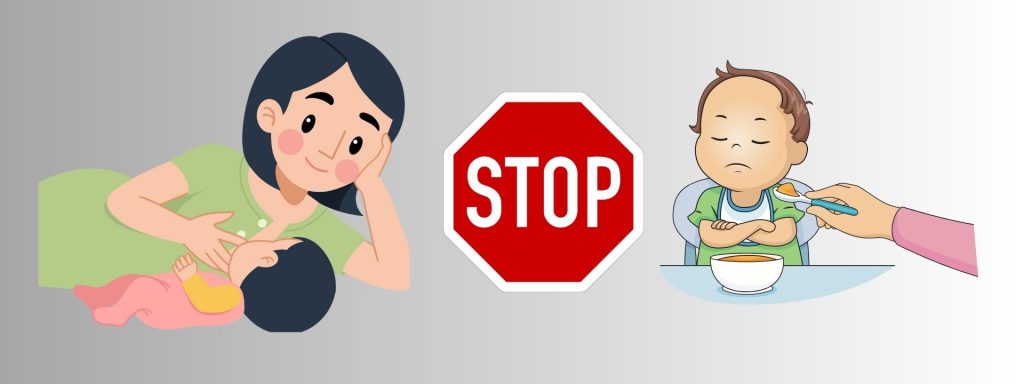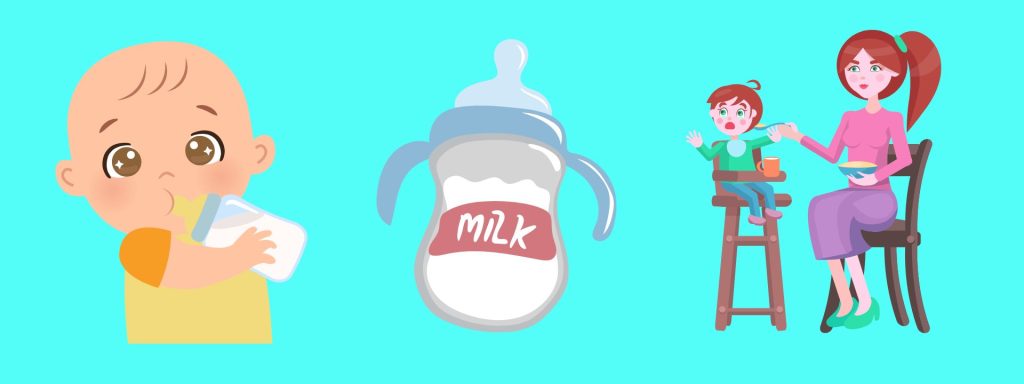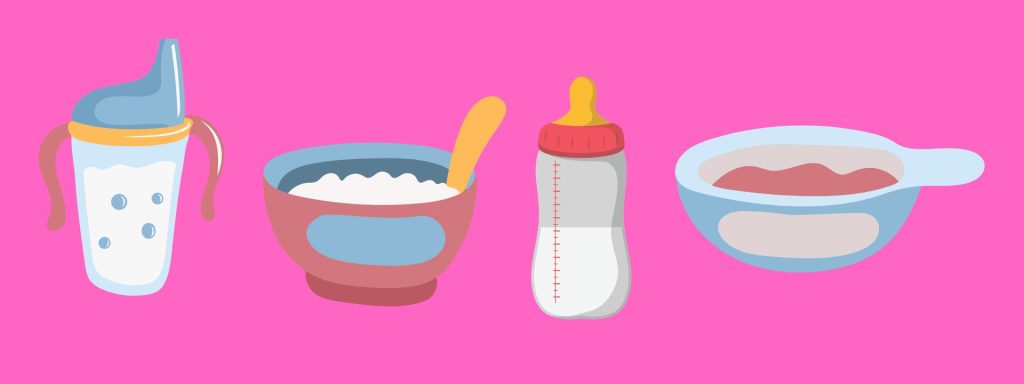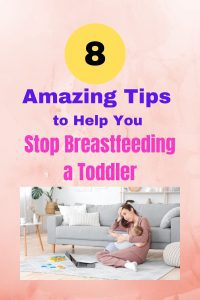Are you wondering how to stop breastfeeding your toddler? Worry no more! Join us as we explore the delicate art of weaning your little one.
Weaning a toddler off breastfeeding is quite exciting. It marks a new season for both the mom and the baby.
But is it always rosy?
Definitely no.
In this insightful guide, we’ll share expert tips and gentle techniques to help you navigate this essential milestone with ease and confidence.
But before then, let’s examine the importance of breastfeeding your baby.
How Long Should you Breastfeed a Baby?
According to WHO, you should breastfeed your baby exclusively for 6 months.
Afterwards, you can gradually introduce age-appropriate food and drinks while continuing to offer breastmilk.
Breast milk is crucial for babies.
WHO notes that consistent breastfeeding helps protect infants against some short and long-term illnesses.
According to CDC, breastfed babies have a lower risk of life conditions like asthma and obesity. They may also experience a lower risk of contracting type 1 diabetes, stomach bugs and sudden infant death syndrome (SIDS).
After six months, WHO encourages women to continue breastfeeding until the baby is about 2 years. Nevertheless, some moms may opt to breastfeed for fewer years or go beyond the recommended 2 years.
How to Stop Breastfeeding a Toddler
One of the challenges most parents encounter is how to stop breastfeeding once their baby become of age.
Often, as they age, babies tend to get attached to breast milk. They seem to enjoy nursing sessions more with time, making it even harder and more dramatic to stop them.
So,
How do you know when your babies are ready to stop breastfeeding?
Honestly, very few toddlers will voluntarily stop nursing. However, sometimes as a mom, you may have other reasons why you cannot continue breastfeeding even if your kid has not surpassed the recommended two years.
As such, consider the following before you take that step of stopping to breastfeed your baby.
- Your infant should be at least over one year old.
- Your baby should be receiving most of his nutrition from solids.
- Your baby should demonstrate the ability to drink well from a cup.
Affiliate Disclosure: As an Amazon Associate, I get a small commission for purchases made from Amazon.com through links in this post. Learn more about our affiliate disclaimer here.
How to Stop Breastfeeding a Toddler Without Pain and Drama.
1. Plan Earlier to Have an Easy Way Out
Whether you want to have a gradual or an abrupt style of stopping your baby from breastfeeding; it’s always crucial to plan.
Planning gives the mother and the baby time to adjust to the new ideas.
As a mother, you want to ensure that your toddler will not lack crucial nutrients after you stop giving your breast milk.
As such, you must have a drink or food that can replace your breast milk.
Giving yourself enough period to sample various alternatives and see your baby’s reaction will save you the heartache of seeing your baby stay hungry or survive on one type of food throughout the day.
As a mom, I would recommend planning your exit strategy at least three months prior.
Giving yourself enough time like 3 months will be appropriate to adjust your mind, emotions and your baby’s needs.
Also, inform any person you think their support will be crucial. This can be your spouse, nanny, or any family member who is close to your toddler.
Here’s what worked for me.
When planning to stop breastfeeding, I concentrated on pumping and bottle-feeding to get my baby away from the breast.
Why?
Because I want them to feed more comfortably on the substitutes rather than relying on nursing as the only source of comfort and refreshment. I gave the breastmilk alongside the alternative substitute that was to take over.
2. Decide whether you’ll do a gradual or an abrupt style of weaning a toddler off breastfeeds
-
Gradual withdrawal of breastmilk
One way to stop breastfeeding your infant is by gradually withdrawing breastmilk, best known as the “don’t offer, don’t refuse” method.
In this arrangement, you never offer to breastfeed your baby. But you don’t refuse when your toddler expresses a desire to breastfeed.
The “don’t offer, don’t refuse” method may be a slow process of weaning a toddler off breastfeeds, but immensely rewarding.
Why?
Because your body gets to adjust to the process with fewer episodes of breast engorgement, emotional breakdown and, of course, the unwanted ranting of the infant.
So
How do you make a gradual withdrawal from breastfeeding?
When you gradually stop your baby from breastfeeding, it’s crucial to ensure that your breasts are less available.
You may choose to be away from the baby most of the time.
I’ve often used this method almost with all my kids because being away helps to reduce the nursing session, giving your toddler allowance to adjust to the new routine.
If you’re a stay-at-home mom, ditching your breastfeeding tops and wearing more layers of clothing to limit your baby from easy access to breasts can be a better way of restricting breastfeeding.
Most infants will fight off your chest, get distracted and leave you before they even touch that breast.
With many layers of clothing, toddlers may demand to nurse less often because of the lack of easy access.
Also, try to postpone and limit breastfeeding sessions.
If breastfeeding thrice daily, you should limit it to two or one session preferably at night. You can do this by distracting your baby whenever they desire to nurse.
Offer them a substitute food and drinks that can satisfy their thirst. Consider incorporating distractive activities like going outdoors for refreshments.
Additionally, shorten each breastfeeding session before stopping it completely.
A child who has had enough food may desire to breastfeed more for comfort than for food.
As such 2-3 minutes of nursing session may be just enough to quench their thirst for breastmilk.
When your baby has had a minute or more, try to distract and point them to something else.
-
Abrupt method of stopping breastfeeding
Some parents may never have the luxury of gradually stopping their toddlers from breastfeeding.
As such, you may prefer to wean your toddler from the breast abruptly.
This approach best suits an infant who nurses fewer than three times daily.
Also, ensure there are no other significant changes in your toddler’s life, like a change of nannies or moving houses. This allows your little one to deal with one change with maximum support.
The following tips may help you to stop your toddler from breastfeeding abruptly.
- Just be gone. Let someone else, preferably someone close to the baby, care for your toddler for a few days. This can be a trusted caregiver, like a spouse, grandparent, or other family member.
- Say “no,” and offer distractions that draw them closer to you like wrapping them around your back and moving around.
- Avoid exposing your breast when you’re around the kid. Wear many layers of clothing to deny them easy access to your breasts.
3. Offer a Soothing Substitute
When you’re planning to stop offering breast milk, it’s essential to have a substitute for this precious commodity called breast milk.
You may choose to introduce a substitute like a bottle of infant formula (for kids younger than 1 year)
Sometimes a cup of plain whole cow’s milk may be fine for infants 12 months or older.
Just experiment to find the suitable substitute your baby will fall for and avail it as often as possible.
Also, if your baby is accustomed to breastfeeding before falling asleep, consider introducing other substitutes like pacifiers or favourite toys to help soothe them.
One of my kids liked being cuddled on the back until he fell asleep and I would do the cuddling religiously.
Some girls will even prefer playing around with their hair as the best distraction to usher them into that sleep once they stop breastfeeding.
You must try different substitutes before deciding what best suits your situation and brings maximum satisfaction to your toddler.
4. Go the Playful Way to Discourage Breastfeeding
There are a variety of playful ways you may use to discourage Breastfeeding. One of them is placing masking tapes on your nipples and pretending they are swollen.
Please note that this is just playing tricks on your toddler’s mind and the outcome depends on your baby’s perspective.
If you don’t like masking tapes, there are a variety of unique anti-breastfeeding supplies to help both of you enjoy the game.
For instance, you may purchase a nipple shield like these nipple guards. Each nipple shield or nipple guard is printed with a sleepy smiley face, to let your toddler know that it’s not time to nurse.
It’s a gentle and playful way to discourage nursing, with the eventual goal of stopping altogether.
Shop now for Mommy’s boobs are sleeping!
5. Commit
Mama, stopping your child from breastfeeding is quite emotional. You will feel guilty for denying your baby his right.
You may also encounter various challenges. Your baby may cry continuously. Sometimes they even refuse to eat. Emotionally you may want to back down, and do a little nursing, especially at night.
Don’t fall into this trap.
For you to stop breastfeeding your toddler successfully, you must remain committed regardless of your emotions.
Being consistent and firm in your decision will make the transition manageable as opposed to when you keep giving in and breastfeeding when your baby throws tantrums.
Learn how to deal with notorious tantrums.
Ensure you wake up at night to offer substitute meals to soothe this desire, and with time; they get used to the idea that breastmilk is not available.
6. Prepare to Deal with Personal Side Effects
Stopping breastfeeding may have various side effects on your body. As such, be prepared to deal with these issues as they arise.
Apart from your baby’s tantrums, you may also experience negative feelings about the whole issue of weaning, especially if your baby is relatively young.
Most women experience an emotional breakdown. You may feel sad and irritable most of the time due to hormonal changes.
How do you deal with the emotional ups and downs?
Regardless of whether you’re doing gradual or abrupt weaning, your hormones are changing.
Mama, I know you may want to stay strong for your baby, but let’s be realistic — even if you do not like breastfeeding, you may still experience mixed emotions on the whole issue.
In my case, I sometimes felt like I have lost some closeness with my sweet baby and felt so sad with a sense of guilt.
But Don’t worry; you’re perfectly fine.
This bond with your child will only deepen as the years go by.
Here are a few tips to deal with emotional turmoil that emerge when you stop breastfeeding.
- Ensure you get sufficient rest and nutrition to help regulate your hormones and make you feel relaxed.
- Find a support group that can offer advice
- Distract yourself by spending time exercising or doing your favorite activities
Additionally, you may experience breast engorgement, especially if it’s an abrupt decision to stop breastfeeding.
If you experience breast engorgement, try to apply worm or cold compressors. Taking a painkiller medicine will also relieve some discomfort.
If you still have some leaky breasts, please have some breast pads to help absorb your mess. I prefer reusable breast pads because of cost implications, but they are equally good.
7. Request for Help
While you may think this is a mother-baby affair, stopping a baby from breastfeeding can have a lot more effect than you think.
If your little one is struggling to give up breastfeeding, it can also take a toll on you.
Having Dad, or another family member, take over nap time and bedtime can help.
It gives you a much-needed break while helping your infant to a new routine especially when you aren’t there for them to ask to nurse.
8. Helping your baby through the process
Weaning may be a challenging season for both mom and baby. While you may struggle with physical pain like engorgement, blocked ducts or mastitis, your baby may have to deal with disrupted digestive issues and emotional dismay.
That is why it’s crucial to remain closer and help your toddler through the process.
While you may never want to deal with an enraged child, offering your support during this time is crucial to their emotional development.
Here are a few tips to help your baby adapt to the process
- Spend quality time together. Whenever they desire to breastfeed, find a better way of calming them rather than dismissing their feelings. I preferred wrapping my son on the back and heading outdoors for fresh air to reaffirm my care for their feelings. Some parents like cuddling their kids to increase the bond
- Ensure that your baby gets enough food and drinks depending on their age. A well-fed baby is less bothered by breastfeeding. Also, good nutrition is paramount to ensure that all their nutritional needs are met.
- Offer a pacifier for your child to suck on in place of your breast.
- If your baby associates bedtime with breastfeeding, it will be best to delegate this activity to a neutral person.
Takeaway
Are you ready to learn how to stop breastfeeding and say goodbye to breastfeeding? Try out these step by step process to wean a toddler off breastfeeds without pain and drama.
Also, do not forget to share fun and creative ways you have used to stop breastfeeding your toddler!
UP NEXT:
- 9 Basic Tips for Increasing Your Breastmilk Supply
- Breastfeeding Must-Haves :The Only Breastfeeding Essentials You’ll Need On Your Shopping List
- 11 Undeniable Reasons Why You Do Not Have Enough Breast milk Supply
- 13 Natural Remedies To Heal Cracked Naples Fast When Breastfeeding
- 9 Essential Breastfeeding Tips To Help New Moms Start Off From Day 1






